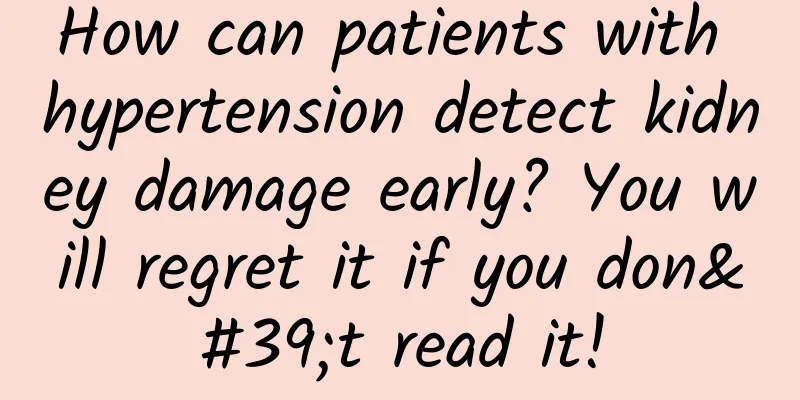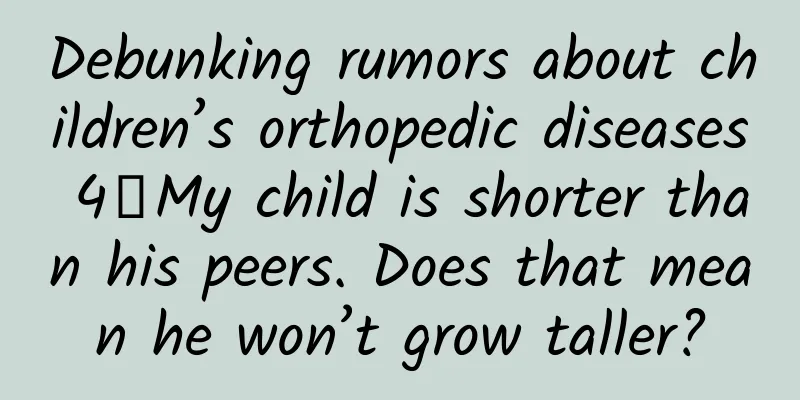How can patients with hypertension detect kidney damage early? You will regret it if you don't read it!

|
Mr. Huang, 70 years old, has suffered from hypertension for more than ten years. Recently, he felt some edema on his face, accompanied by less urine. He went to the hospital for a check-up and was told that there was a problem with his kidneys. In fact, this phenomenon is very common. Many hypertensive patients only come to see a nephrologist when they develop into the late stage of chronic kidney disease. Hypertensive kidney damage is one of the serious complications of hypertension. As the course of the disease prolongs, hypertensive patients will experience proteinuria, edema, and reduced glomerular filtration rate, and then renal failure. Therefore, it is very necessary for hypertensive patients to conduct early screening for kidney damage and take effective methods to slow down the rate of kidney damage caused by hypertension. Self-observation to detect early signs of kidney damage I often hear some patients with hypertension complain: "Why do I have to get up so frequently at night? I have to go to the bathroom several times a night. This affects my sleep!" At this time, the doctor will suggest that the patient do a urine test first. This is because when high blood pressure causes kidney damage, the urine concentration function decreases earlier, and the patient's earliest subjective feeling is increased nocturia. In addition, patients with high blood pressure and kidney disease should also pay attention to the characteristics of urine, such as whether the urine is more foamy or darker in color. If there are these conditions, it indicates that the kidneys are damaged and you need to be extra vigilant. Regular check-ups to provide evidence of kidney damage The kidneys have a strong reserve capacity, and there are often no or very few signs in the early stages of the disease. Diagnosis relies heavily on laboratory tests. Kidney damage in patients with hypertension is not impossible to prevent. As long as urine and other indicators are checked regularly, early detection and early control are possible. Urine tests 0 1 Urinalysis can show whether the patient has hematuria, proteinuria, tubular urine, etc. The disadvantage of urinalysis is that it has limited sensitivity and sometimes easily misses some hypertensive patients with mild renal damage. 0 2 Urine albumin quantitative Urine albumin quantitative detection has better sensitivity than routine urine detection. It is recommended that ordinary hypertensive patients should be tested at least once a year, and patients with increased urine albumin should be checked once every 3 months. 0 3 Urinary β2 microglobulin Urinary β2 microglobulin is one of the sensitive indicators reflecting early renal damage in patients with hypertension, but interfering factors such as infection, fever, and recent vaccination must be excluded. 04 Urinary N-acetyl-β-D-glucosaminidase Urinary N-acetyl-β-D-glucosaminidase is relatively stable in urine and cannot be filtered through the glomerulus. It can be used as an early sensitive indicator of hypertensive renal tubular damage. 05 Retinol Binding Protein When the renal tubular function is impaired, the retinol binding protein in the urine may increase significantly, and its excretion amount in the urine can be used as one of the sensitive indicators of renal function impairment. Blood tests 01 Renal function test In clinic, serum urea nitrogen, creatinine and uric acid are commonly used as indicators for evaluating renal function. The renal function of hypertensive patients changes with the course of the disease. Dynamic observation of changes in the patient's renal function can better reflect the patient's actual renal function than a single renal function test. Generally speaking, if the test results are normal, you can check again after 3 to 6 months. If the first test results are abnormal, the interval between tests should be shortened, and a re-examination is required every 1 to 2 months. 02 Serum cystatin C Serum cystatin C is a simple, accurate and sensitive indicator for assessing glomerular filtration rate, which can detect impaired renal filtration function at an early stage. 03 Imaging examination For patients with hypertension, renal B-ultrasound and renal ECT are currently the most commonly used imaging examinations for screening renal damage. Ultrasound is an important auxiliary examination method for diagnosing kidney disease because it is non-invasive, inexpensive, and not affected by renal function. Renal ECT can accurately measure the glomerular filtration rate of both kidneys, detect renal insufficiency at an early stage, and is also an important basis for staging renal damage. 05 Renal puncture biopsy Patients with clear diagnosis of hypertensive renal damage generally do not need renal puncture biopsy. However, when other factors other than hypertension are suspected to be involved in the progression of kidney disease or clinical diagnosis is difficult, renal biopsy can be performed in the absence of contraindications to renal puncture. |
<<: The relationship between salt and high blood pressure, it’s hard to say everything about “salt”!
>>: These tips can help you detect whether you have chronic kidney disease as early as possible!
Recommend
How many months does a pregnant woman need to wear maternity pants?
After pregnancy, your body shape will gradually c...
What are the symptoms of chronic endocervicitis?
Chronic endocervicitis is a disease that occurs i...
Tooth extraction can really kill you! From hammering teeth to minimally invasive techniques, here's a look at the evolution of human tooth extraction surgery!
Tooth extraction is a "terrifying" oper...
Best recipes for menstruation
Women must pay special attention to their diet du...
What foods should not be eaten for lobular hyperplasia of the breast
For example, lobular hyperplasia is a relatively ...
What to do if you have severe hair loss during pregnancy
Generally speaking, after pregnancy, the change o...
What tests can detect cervical polyps?
Cervical polyps are a manifestation of chronic ce...
Taking "Lijing" type hypoglycemic drugs, do you feel that your urine is sticky on your feet? This shows that the drug is effective in lowering blood sugar and protecting cardiovascular health.
A diabetic patient told Huazi that after taking e...
Is postpartum swelling caused by uterine prolapse?
When postpartum bloating occurs, it may be caused...
What is the cause of vaginal bleeding? Learn 7 insider information early
There are many reasons for vaginal bleeding. If n...
What is going on?
Irregular menstruation is a common gynecological ...
I feel cold all over on the first day of my period
Women will encounter various problems during thei...
What to do if the vulva is itchy and smells bad
Friends who suffer from vulvar itching need to pa...
Can pregnant women use topical medications for skin?
Some pregnant women may experience some allergies...









